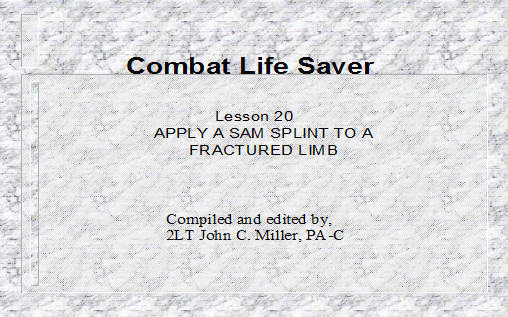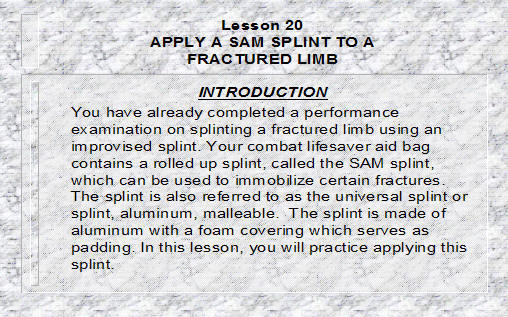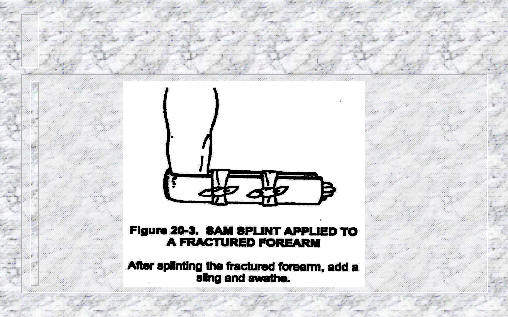APPLY A SAM SPLINT TO A FRACTURED LIMB
Click here to download the presentation.



Lesson 20
APPLY A SAM SPLINT TO A
FRACTURED LIMB
INTRODUCTION
You have already completed a performance examination on splinting a fractured limb using an improvised splint. Your combat lifesaver aid bag contains a rolled up splint, called the SAM splint, which can be used to immobilize certain fractures. The splint is also referred to as the universal splint or splint, aluminum, malleable. The splint is made of aluminum with a foam covering which serves as padding. In this lesson, you will practice applying this splint.
APPLY A SAM SPLINT TO A
FRACTURED LIMB
TASK
Apply a SAM splint to a fractured limb.
CONDITIONS
Given a simulated casualty with a fractured limb and a SAM splint.
STANDARDS
Score a GO on the performance checklist.
PREPARE THE CASUALTY FOR
APPLICATION OF THE SPLINT
Question:
If your evaluation indicates that the casualty has a fractured forearm and you have already exposed the fracture site. What do you need to do before splinting the limb?
Response:
Take the casualty’s pulse below the fracture site.
Check for a pulse below the fracture site.
PREPARE THE CASUALTY FOR
APPLICATION OF THE SPLINT
Question:
What would you do if no pulse is present?
Response:
Splint the limb and evacuate the casualty as soon as possible.
Question:
If you found a pulse and the forearm looks deformed. Should you straighten the forearm before you splint it?
Response:
No.
APPLY THE SAM SPLINT TO A FRACTURE
of the
FOREARM, WRIST, LOWER LEG, OR ANKLE
Fractured Forearm or Wrist
Unroll the SAM splint and flatten it.
Fold the SAM splint in half so it is a tall V-shape.
Bend the edges of the splint in until the shape of the splint generally conforms to the curve and shape of the limb being splinted. (Each half of the splint will have a U-shape.) Bending the edges also increases the rigidity of the SAM splint.
Prepare cravats from muslin bandages to be used in securing the splint.
APPLY THE SAM SPLINT TO A FRACTURE
of the
FOREARM, WRIST, LOWER LEG, OR ANKLE
Question:
If muslin bandages are not available, what could you use as securing material.
Response:
Strips of cloth from a blanket or clothing or the tape from the aid bag.
Apply the SAM splint to the forearm so the bend is at the elbow and the fracture is between the two sides of the splint. Adjust the shape of the SAM splint to conform to the limb, if needed.
APPLY THE SAM SPLINT TO A FRACTURE
of the
FOREARM, WRIST, LOWER LEG, OR ANKLE
Question:
I am going to secure the SAM splint using these cravats. Where should I apply the cravats?
Response:
At least one cravat above the fracture site and at least one below the fracture site.
Secure the splint using at least two cravats.
Secure the splint above the fracture site and below the fracture site.
APPLY THE SAM SPLINT TO A FRACTURE
of the
FOREARM, WRIST, LOWER LEG, OR ANKLE
Question:
Should I also apply a cravat over the fracture site?
Response:
No.
Tie the tails of the cravats in a nonslip knot on the outside of the splint. Tuck the ends of the tails into the cravat to prevent accidental entanglement when the casualty is moved.
APPLY THE SAM SPLINT TO A FRACTURE
of the
FOREARM, WRIST, LOWER LEG, OR ANKLE
Check the casualty’s pulse below the most distal cravat. Loosen the cravats and reapply the splint, if needed. Periodically check distal pulse to ensure that swelling has not compromised the pulse.
Quickly apply a sling and swathe to further immobilize the fracture.
APPLY THE SAM SPLINT TO A FRACTURE
of the
FOREARM, WRIST, LOWER LEG, OR ANKLE
Fractured Lower Leg or Ankle
Quickly shape the splint.
Check the casualty’s pulse below the fracture site. Loosen footgear, if needed. Apply the splint to the casualty’s lower leg with the bend on the bottom of the footgear.
Secure the splint with cravats.
Recheck the casualty’s pulse.
APPLY THE SAM SPLINT TO A FRACTURE
of the
UPPER ARM (HUMERUS)
Fold the SAM splint into an irregular (uneven) V-shape so one side of the V is about 4 to 6 inches shorter than the other.
Bend the edges of the splint so the sides of the splint are U-shaped and generally conform to the shape of the limb being splinted.
Prepare the cravats.
Apply the SAM splint to the fractured limb so the short side is in the casualty’s armpit (but not pressing on the armpit), the long side extends to the shoulder, and the upper arm is between the two sides of the splint.
APPLY THE SAM SPLINT TO A FRACTURE
of the
UPPER ARM (HUMERUS)
Adjust the shape of the SAM splint to conform to the limb, if needed.
Secure the splint using at least two cravats.
Secure the splint above the fracture site and below the fracture site. Do not apply a cravat directly over the fracture site.
Tie the tails of the cravats in a nonslip knot on the outside of the splint and tuck in the tails.
CHECK THE CASUALTY
Question:
What should I do after I have secured the splint?
Response:
Check the casualty’s circulation.
Check the casualty’s pulse below the most distal cravat.
CHECK THE CASUALTY
Question:
What should you do if you felt a pulse before applying the splint, but not after applying the splint?
Response:
Loosen the cravats, make sure the end of the splint is not pressing into the armpit, and retie the cravats.
Question:
What should you do if the casualty does not have a pulse below the fracture even after you reapply the splint?
Response:
Evacuate the casualty as soon as possible.
CHECK THE CASUALTY
Question:
What else can you do to immobilize the fracture?
Response:
Apply a sling and swathe. Quickly apply a sling and swathe to further immobilize the fracture.
APPLY A SAM SPLINT TO A
FRACTURED LIMB
CLOSING
The SAM splint provides you with a prepadded rigid object from which a splint can be made. It is especially useful when other rigid objects cannot be obtained easily.
Questions